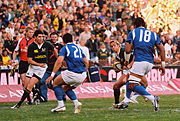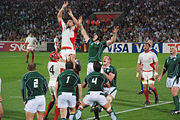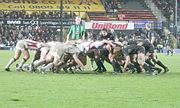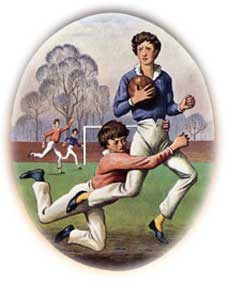Rugby union
2008/9 Schools Wikipedia Selection. Related subjects: Sports
Rugby union (short for rugby union football) is an outdoor sport played with an oval ball by two teams of 15 players each. It is one of the two main codes of rugby football, the other being rugby league. In both codes, there is also a seven-a-side variant, called rugby sevens, which is played under modified rules and is faster.
Rugby union is often referred to as simply rugby or rugger. It is sometimes known as football, or, in countries where rugby league is also played, as union.
Overview
A rugby union match lasts for 80 minutes, with a short interval (not more than 10 minutes) after the first 40 minutes; at under-19 level and below, games are limited to a maximum of 70 minutes, with an interval after 35 minutes.
A match is controlled by a referee, who is assisted by two touch judges. For professional matches, a television match official (TMO), commonly called the video referee is often employed, usually to advise the referee on matters pertaining to the scoring of tries and dropped goals.
The object of the game is to score as many points as possible. The team that scores the greater number of points is the winner.
Points are awarded for scoring a try or kicking a goal. A try, which is worth 5 points, is scored when the ball is grounded within the opponent's in-goal area. A goal is scored by kicking the ball between the posts and over the crossbar of the opponent's goal.
There are three ways to score a goal: (i) a dropped goal (scored in open play where the ball must hit the ground immediately before it is kicked); (ii) a penalty goal (awarded after the opposing side infringes against the laws of rugby and may be kicked from a stationary ground position or by drop kick); and (iii) a conversion (awarded after a try is scored) by either a drop kick or a place kick. A penalty or dropped goal is worth 3 points; a conversion is worth 2 points.
The pitch must be no more than 100 meters in length, not including the in-goal area. The depth of the in-goal area can vary but must be at least 10 meters and no more than 22 meters. The width of the pitch may also vary but must be no more than 70 meters wide. The goal posts are situated on the centre of the goal line with the upright posts placed 5.6 meters apart and the crossbar is placed 3 meters above the ground in an 'H' shape. The overall height of the goal posts must be over 3.4 meters.
A typical passage of rugby takes the following form: the team in possession of the ball moves the ball up the field in an effort to ground the ball over the opponents' goal-line in order to score a try until such time as the ball carrier is tackled. They then form a ruck in order to win the ball back. This process repeats until one team makes a mistake that violates the Laws of the game, moves off the field of play or a try or goal is scored.
The team in possession may choose to advance by kicking the ball forward. The ball may be passed from one player to another as long as the ball is not thrown forwards. Rugby union is one of the few ball games where the ball cannot be passed forwards. Any team mate nearer the opposition goal than the ball-carrier is off-side and must not interfere with play, meaning that American football-style blocking is forbidden.
The team not in possession attempts to stop the ball carrier by tackling them, which consists of grabbing hold of them and bringing them to ground. A tackled player must pass or release the ball, allowing the opposition to contest possession of the loose ball. Play does not stop unless there is an infringement of the laws, or the ball / ball-carrier leaves the field of play.
If the ball goes into touch (out of the field of play), the game restarts with a line-out. If the game stops because of an infringement, play restarts with either a scrum, free kick or penalty kick (depending on the severity of the infringement) awarded to the non-infringing team.
The attacking team may score by kicking the ball between the posts and over the cross-bar. When attempting to kick for goal the ball may only be kicked from the ground, either from a place kick or drop-kick following the award of a penalty or from a drop kick in open play. A successful kick at goal is worth three points.
The attacking team may also score by grounding the ball in the in-goal area. This is called a " try" and is worth five points. A team that scores a try is given the opportunity to attempt to kick a goal, known as a conversion kick; the conversion kick is worth two points if successful. The conversion kick must be taken from in line with where the try was scored; it can be taken from anywhere along that line.
Tries are the main form of scoring, and the primary aim of most teams is to score tries. Drop goals and penalty kicks are usually augmenters, a safer option against a steadfast defense or to punish ill-disciplined opposition. On some (usually rare) occasions, a team may be awarded a penalty try, if their opponents commit a foul which is deemed by the referee to have illegally prevented a try, or if they have persistently stopped play close to the try line through foul play.
Players

A rugby union team consists of 15 players: eight forwards, numbered 1 to 8, and seven backs, numbered 9 to 15. Depending upon the competition, there may be up to seven replacements (substitutes or reserves). Professional rugby contains seven reserves, with a player being allowed to be substituted only once, unless they are a front-row specialist player and are replacing an injured front-row player. Another exception to this rule is the "blood bin", where a player with a visible and bleeding injury must leave the field and then return to continue play after receiving treatment providing this is within 15 minutes of the player leaving the field (actual time, not game clock). A player sent to the blood bin may be replaced by another player during treatment. If the bloodied player returns to play within 15 minutes, it is not counted as a substitution.
The main role of the forwards is to gain and retain possession of the ball. They take part in set pieces of the scrum and the line-out. Generally, forwards are larger than the backs, which generally makes them stronger but slower. Forwards also have a role in taking the ball forwards, but generally do so by driving into the opposing forwards. Increasingly back row forwards such as flankers and the number 8 are becoming athletic and fast, staying out of the breakdown to participate in running moves with the backs.
The role of the backs is to move the game forward by running or kicking the ball. The scrum-half will gain possession of the ball from the forwards and usually feed it to the fly-half also known as the outside half (no.10) who then controls how the attacking team will proceed. The backline will tend to score its tries by focusing on the tactical placement of players, creating holes in the opposition defense line. A successful backline will cause the opposition defense to commit too many players at strategic points creating space to open up for the faster, outside backs (wingers and fullback).
The following diagram locates the various positions in the 15-man team. All members of the starting 15 wear jerseys, numbered from 1 to 15, and keyed to their positions (though alternatives exist; see rugby union positions and rugby union numbering schemes for more information). The first eight players, known as forwards or the pack, play in the scrum. The remaining seven players are the backs.
| Rugby union positions | ||||||||||||||||||||||||||||||||||||||||||||
|---|---|---|---|---|---|---|---|---|---|---|---|---|---|---|---|---|---|---|---|---|---|---|---|---|---|---|---|---|---|---|---|---|---|---|---|---|---|---|---|---|---|---|---|---|
|
Equipment
A traditional rugby union kit consists of a collared jersey (often imitated by fashion labels and called a " rugby shirt"), shorts, long socks and boots with studs. Additional items of clothing that may be worn include mitts (fingerless gloves), shin guards, shoulder pads, and headgear. Most players also opt to wear a mouthguard to protect them from concussion and damage to their teeth. Women rugby players are also allowed to wear protective chest pads.
The IRB bans certain items of clothing: anything contaminated by blood, sharp or abrasive items, jewellery, gloves (but not mitts), shorts with padding, or any communication device. All items of clothing must conform to the specifications in IRB Regulation 12, and shoulder padding and headgear worn by players must bear the IRB Approval Mark.
Prior to a match, the referee or a touch judge inspects the players' clothing and studs. At any time before or during the match the referee may instruct a player to remove any item of clothing that is deemed to be dangerous or illegal. In this case the player may not take any further part in the game until the item is removed. If, during the pre-match inspection, a player is told that an item is banned and is subsequently found to be wearing it, the player is sent off for misconduct. A player may not leave the playing area to change items of clothing unless these are bloodstained.
History
The origin of rugby football is often credited to a young man named William Webb Ellis who "took the ball in his arms (i.e. caught the ball) and ran" while playing a form of football at Rugby School in 1823. However historians have questioned the authenticity of this story, beginning with an official investigation by the Old Rugbeian Society in 1895. Nonetheless, the trophy for the Rugby World Cup bears the name of "Webb Ellis" in his honour, and a plaque at the school commemorates the "achievement". Playing football has a long tradition in England, and football games had probably taken place at Rugby School for 200 years before three boys published the first set of written rules in 1845. However, the game they presented resembled " Hurling to Goal", described by Richard Carew in his 1602 work, 'Survey of Cornwall'. Cornish hurlers traveled to London to play 'demonstration matches' of the sport several times in the 17th century.
Until the formation of the Football Association (FA) in October 1863 opposing football teams agreed on a set of rules before each match. Teams that competed against each other regularly tended to agree to play a similar style of football.
Rugby football has a claim to the world's first "football clubs"; the Barnes Club (as it was known), formed in London in 1839, and Guy's Hospital Football Club (1843). However the continuity of these two clubs has not been established by documentation. Dublin University Football Club is the world's oldest documented football club in any code, having been formed in 1854; it currently plays rugby union in the All Ireland League Division Two. Likewise Edinburgh Academical Football Club was formed in Scotland in 1857-58. Blackheath Rugby Club was founded in 1858 and is the oldest documented rugby club in England. It was a founding member of The Football Association. When it became clear that the FA would not allow running with the ball in hand and to "charge, hold, trip or hack [an opponent], or to wrest the ball from him" ('hack' meaning to kick opposing players' legs, a feature of the rugby game at the time), Blackheath withdrew from the FA, just over a month after the initial meeting. Other rugby clubs followed this lead and did not join the FA.
For the next few years rugby clubs continued to agree on rules before the start of each game as they had always done, but on January 26, 1871, the Rugby Football Union (RFU) formed, leading to the standardisation of the rules for all clubs in England that played a variety of the Rugby School laws. Soon most countries with a sizeable rugby community had formed their own national unions. In 1886, the International Rugby Board (IRB) become the world governing and law-making body for rugby. The RFU recognised it as such in 1890.
Rugby was introduced into New Zealand by Charles John Monro, son of Sir David Monro, then speaker of the New Zealand House of Representatives. The younger Monro had been sent to Christ's College, East Finchley, in north London, England. That school had adopted rugby rules and Monro became an enthusiastic convert. He brought the game back to his native Nelson, and arranged the first rugby match, between Nelson College and Nelson Football Club, on May 14, 1870. However a form of rugby was being played at Christ's College, Canterbury in 1853.. In North America, rugby developed into American football and into Canadian football.
The 1890s saw a clash of cultures within the game, between working men's rugby clubs of northern England and predominantly middle-class southern clubs, a dispute revolving around the nature of professionalism within the game. Several clubs had made payments to their players to compensate for loss of working time, when either playing or training. These "broken time" payments were seen as an affront to the Corinthian ideal by the gentlemen who administered the game. On August 29th, 1895, 22 Lancashire and Yorkshire clubs split from the RFU and met at the George Hotel in Huddersfield to form the Northern Rugby Football Union (NRFU), commonly called the Northern Union (NU). NRFU rules gradually diverged from those of rugby union, although the name rugby league did not become official until the Northern Rugby League formed in 1901. The name Rugby Football League (RFL) dates from 1922. A similar schism opened up in Australia and other rugby-playing nations. Initially, rugby league in Australia operated under the same rules as rugby union. But after a tour by a professional New Zealand team in 1907 of Australia and Great Britain, and an Australian Rugby League tour of Great Britain the next year, rugby league teams in the southern hemisphere adopted rugby league rules. For clarity and convenience it became necessary to differentiate the two codes of rugby. The code played by those teams who remained in national organisations which were members of the IRB became known as "rugby union". The code played by those teams which played "open" rugby and allowed professionals as well as amateurs became known as "rugby league".
On 26th August, 1995 the IRB declared rugby union an "open" game and removed all restrictions on payments or benefits to those connected with the game. It did this because of a committee conclusion that to do so was the only way to end the hypocrisy of shamateurism and to keep control of rugby union (there were rumours that Rupert Murdoch was planning to finance a southern hemisphere professional league). The move from amateurism to professionalism has arguably increased the quality of rugby being played. However, professionalism has meant a huge increase in the gap between the top nations and the second tier. Alongside the success stories there have been some famous rugby clubs which have not coped well with the new era. Increasing popularity in recent years has led to diversification; women's rugby is increasingly popular in the US and Canada.
The professionalisation of rugby union has created a larger and more international supporter base than before and very large crowds in international competitions. Sponsorship and club attendance is also increasing in rugby union, with many English premiership clubs seeking to expand their existing ground capacity. Attendances for major international rugby union matches are generally sell-outs. As rugby union has grown, the increased funds generated have allowed the opportunity for big money deals bringing top-level rugby league players over to rugby union.
Governing Bodies
The recognised international governing body of rugby union (and associated games, such as sevens) is the International Rugby Board (IRB). The IRB headquarters are located in Dublin.
Six regional associations are members of the IRB; these are:
- Africa: Confederation of African Rugby (CAR)
- Asia: Asian Rugby Football Union (ARFU)
- North America & West Indies: North America and West Indies Rugby Association (NAWIRA)
- Europe: FIRA - Association Européenne de Rugby (FIRA-AER)
- Oceania: Federation of Oceania Rugby Union (FORU)
- South America: Confederación Sudamericano de Rugby (CONSUR)
National unions oversee rugby union within individual countries. These are affiliated both with the IRB and with their respective regional association.
Worldwide

Rugby union has established itself as a popular sport, particularly in Australia, Argentina, Canada, England, Fiji, France, Georgia, Ireland, Italy, New Zealand, Romania, Samoa, Scotland, South Africa, Tonga and Wales. Other countries with a long tradition of rugby, although as a minority sport, include USA, Japan, India, Singapore, Malaysia, Uruguay, Holland, Russia, Portugal, Spain and numerous African countries. For example, the USA are the reigning Olympic champions, from the Paris Olympics in 1924 (the last year rugby was played as an Olympic sport), when they beat France in the final. Rugby union is gaining popularity in Italy following its acceptance into the Six Nations. Japan unsuccessfully bid to host the 2011 World Cup losing to New Zealand. Rugby union also has a following in North America, with both Canada and the USA regularly qualifying for the World Cup. One of the attractions of rugby union is the great diversity in playing styles that have been adopted by the various countries that play the game. This diversity of styles of play is partially due to the varying interpretations of the laws of the game. Perhaps the greatest influence on styles of play is the playing environment such as the mud of a wet English field, or on a hard, sparsely grassed paddock in Australia, or at altitude on the South Africa veldt , in the humidity of Hong Kong or the snow of a Scottish hillside.
The International Rugby Board (IRB), founded in 1886, governs the sport worldwide and also publishes the game's laws and rankings. There are currently 95 full members and eight associate member countries. According to IRB figures, rugby union is played in over 100 countries spanning six continents by men and women of all ages. The IRB controls the Rugby World Cup, the Women's Rugby World Cup, Rugby World Cup Sevens, IRB Sevens World Series, Under 21 World Cup, Under 19 World Championship, and the Super Cup. It holds votes to decide where all of these events shall be held, except in the case of the Sevens World Series. For that competition, the IRB contracts with several national unions to hold individual events.
Records of women's rugby go back over 100 years - the first mentions of the game being in New Zealand in 1891 and France ten years later. In the past 30 years, however, the game has expanded massively and (according to the RFU) it is now played in over 80 countries worldwide.
' Touch rugby', a version of the game in which 'tackles' are made simply by touching an opponent, is gaining popularity.
Major international competitions

The most important tournament in rugby union is the Rugby World Cup, a men's tournament that takes place every four years between the elite national rugby union teams. South Africa are the current world champions, winning the 2007 tournament held in France. They beat England, who were attempting to become the first country to retain the title, having won it in 2003. The fact that four countries have won the last five World Cups confirms the level of competition in the tournament, creating intense interest from supporters, the media and major sponsors. Major international competitions in the northern and southern hemisphere are the Six Nations Championship and the Tri Nations Series, respectively.
The Six Nations is an annual competition involving northern hemisphere teams England, France, Ireland, Italy, Scotland and Wales. Each country plays the other five once, the modern tournament traces its roots to the first ever international game, when England lost by one goal to Scotland at Inverleith Park, adjacent to Raeburn Place, Edinburgh in 1871. In the 1880s, Wales and Ireland joined to create the Home International Championships. France joined the tournament in the 1900s and in 1910 the term Five Nations first appeared. However, the Home Nations (England, Ireland, Scotland, and Wales) excluded France in 1931 amid a run of poor results, allegations of professionalism (rugby union was officially amateur until 1995) and concerns over on-field violence. France then rejoined in 1939-1940, though World War II halted proceedings for a further eight years. France has played in all the tournaments since WWII, the first one of which was played in 1947. In 2000, Italy became the sixth nation in the contest.
The Tri Nations is an annual international rugby union series held between the southern hemisphere teams of Australia, New Zealand and South Africa. The series was initially played on a home and away basis with the three nations playing each other twice. In 2006 a new system was introduced where each nation plays the others three times rather than two. In 2007 the teams will play each other only twice, as it is a World Cup year. The IRB had been brokering a deal which could have seen Argentina admitted to the competition in 2008, but it was later confirmed that the Tri Nations would not be expanded until at least 2010. Amidst all the rugby union competitions are also the autumn and summer Tests, which take place between September to December and June to August. These are played by the major rugby union nations on a home or away basis.
Women's International Rugby began in 1982. Over six hundred women's internationals have now been played by over forty different nations. As well as the women's World Cup event (which takes place every four years), there are also other regular tournaments, including a Six Nations run in parallel to the men's competition.
In the military
The earliest record of rugby being played in the Army was during the Crimean War (1854-56). In its early days rugby was very much the preserve of the officers, it was not until the early 1870s that the game became inclusive of all ranks.
The Royal Navy and in particular the British Army did much to spread enthusiasm for rugby worldwide as it did for the other great British national games; cricket and football. Army regiments stationed throughout the British Empire had regimental teams who played locally. Whilst serving in India the 3rd (East Kent) Regiment (The Buffs) and the 62nd (Wiltshire) Regiment (Duke of Edinburgh's) both had a hand in the conception of the Calcutta Cup, the oldest trophy in the history of international rugby.
The Army Navy Match, which is currently played at Twickenham each year was first played in 1878, but did not become annual event until 1909.
In 1905 the Royal Navy Rugby Union (RNRU) was formed and the Army Rugby Union the following year (1906), both service unions were affiliated to the Rugby Football Union (RFU) on their formation.
Women's rugby was introduced into the Armed Services in the early 1990s.


